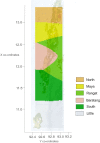Population structure in the Andaman keelback, Xenochrophis tytleri: geographical distance and oceanic barriers to dispersal influence genetic divergence on the Andaman archipelago
- PMID: 30324026
- PMCID: PMC6183555
- DOI: 10.7717/peerj.5752
Population structure in the Andaman keelback, Xenochrophis tytleri: geographical distance and oceanic barriers to dispersal influence genetic divergence on the Andaman archipelago
Abstract
Limited gene flow between populations due to geographic distance, presence of barriers or inherent low dispersal ability leads to the formation of genetically structured populations. Strong population structure indicates lowered levels or absence of gene flow which might lead to inbreeding and loss of genetic capacity to recuperate from anthropogenic stress and natural calamities. Terrestrial reptiles are generally known to have low dispersal abilities and few studies have explored drivers of their population structure on continental islands, where both anthropogenic stress and natural calamities are relatively common. We investigated the population structure and drivers of diversification of the Andaman keelback (Xenochrophis tytleri), an endemic, terrestrial and freshwater snake species in the Andaman archipelago, a continental group of islands in the Bay of Bengal. Data was collected from 86 individuals from seven islands and 78 individuals were sequenced for the gene Nuclear Dehydrogenase subunit 4 to identify the number of populations and distribution of genetic diversity across populations. We found 11 haplotypes on seven islands and observed high genetic differentiation between seven populations defined island-wise (F ST = 0.82). We further tested the number of populations by incorporating spatial data into Bayesian Clustering Analysis (GENELAND) and identified six populations of the Andaman keelback. We tested for the influence of Isolation-by-distance on these populations. While the overall trend showed a positive correlation between geographic and genetic distance, a correlogram revealed that the positive correlation disappears beyond ∼20-40 km. We also tested for the presence of geographical barriers to gene flow using Monmonier's algorithm (SPADS), which identified five barriers to dispersal confirming that there are oceanic barriers to dispersal for some island populations of the Andaman keelback. As the Andaman Islands are arranged almost in a straight line from North to South, our data are insufficient to tease apart the roles of geographical distance and barriers to gene flow. We conclude that salt waters between near islands are weak barriers and as the geographical distance between islands increases, so does the strength of the barrier.
Keywords: Andaman Islands; Colubridae; Dispersal; Endemism; Gene flow; Phylogeography; Population genetics.
Conflict of interest statement
Kartik Shanker is a cofounder of Dakshin Foundation, Bangalore.
Figures







References
-
- Andrews HV, Sankaran V, Sankaran V. Sustainable management of protected areas in the Andaman and Nicobar Islands. 2002. https://www.cabdirect.org/cabdirect/abstract/20033117071 https://www.cabdirect.org/cabdirect/abstract/20033117071
-
- Arèvalo E, Davis SK, Sites JW. Mitochondrial DNA sequence divergence and phylogenetic relationships among eight chromosome races of the Sceloporus grammicus complex (Phrynosomatidae) in central Mexico. Systematic Biology. 1994;43(3):387–418. doi: 10.2307/2413675. - DOI
-
- Avise JC, Arnold J, Ball RM, Bermingham E, Lamb T, Neigel JE, Reeb CA, Saunders NC. Intraspecific phylogeography: the mitochondrial DNA bridge between population genetics and systematics. Annual Review of Ecology and Systematics. 1987;18(1):489–522. doi: 10.1146/annurev.es.18.110187.002421. - DOI
LinkOut - more resources
Full Text Sources
Research Materials

